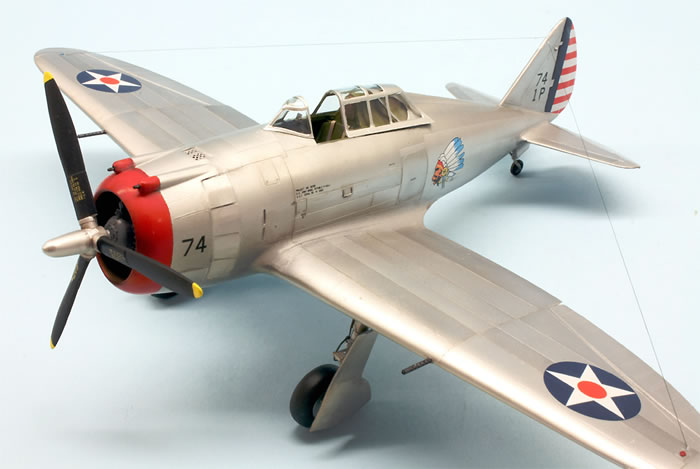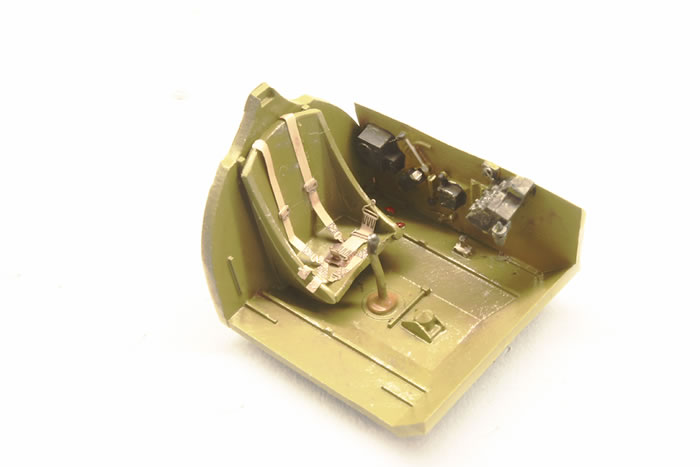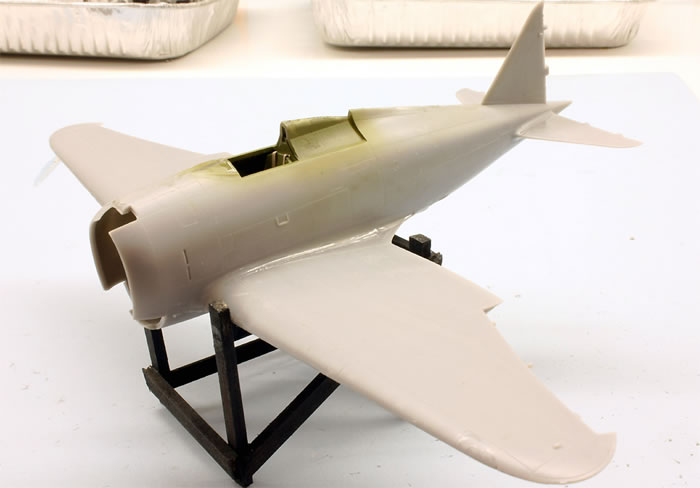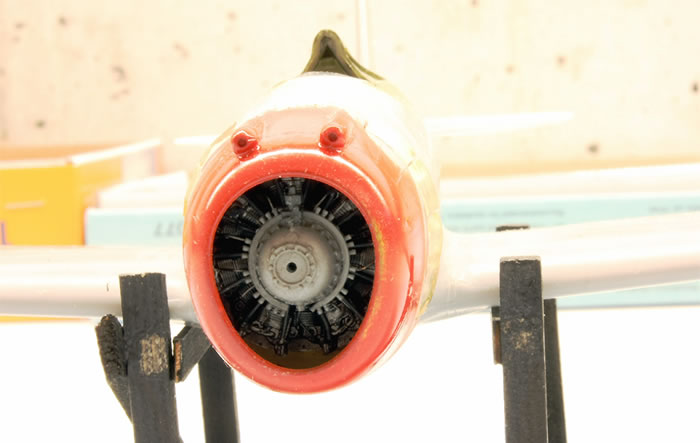Dora Wings' 1/48 scale
Republic P-43 Lancer
by Roland Sachsenhofer

The history of the P-43 Lancer is closely linked to the development of one of the most famous icons of American aviation, the P-47 Thunderbolt. Just one look at the amazingly similar appearance of the two aircraft can prove this claim. It is interesting to note that the P-43 is only an intermediate step from the beginnings of the development, which started with the P-35 in the first half of the 1930s, to the technically perfected P-47, which was to take off for its maiden flight in May 1941.
Alexander Kartweli, an active and influential developer at Seversky Aircraft Production and, like company founder Alexander de Seversky himself, a Russian emigrant, played a leading role in all these designs.
His first major design, the P-35, had a powerful engine and superior flight characteristics , which earned Seversky victory over competitors Curtis and Northrop in a tender by USAAC in 1935, and a contract for series production.

With the AP-2 racing aircraft derived from this successful design, and especially with the AP-4 ("Advanced Pursuit 4"), which emerged from it a little later, a constructive design was found which was to remain characteristic for the following fighter aircraft of Seversky/Republic: the already remarkable performance of the engine could be increased even further with an ingeniously installed exhaust gas turbocharger. The previous low-wing aircraft was transformed into a mid-wing aircraft by the lines of the voluminous turbocharger, which were routed under the wing spar.
It was here, incidentally, that the "Razorback" design of the upper fuselage nose, typical of Republic, first appeared.
As early as May 1941 the USAAC ordered thirteen pre-series machines of what is now called the YP-43, which were delivered by September 1941. The outstanding speed of the P-43 also prompted the development of a version powered by the Pratt & Whitney R-2180 Twin Hornet or, alternatively, by the Pratt & Whitney R-2800, which, as the P-44 Rocket, was also ordered by USAAC in the order of 827 machines.
All these developments had taken place before the USA entered the war. The news from Europe, however, showed clearly even then that the performance of both the P-43 and the P-44 would not be sufficient.
This realisation had two consequences: on the one hand, all efforts were now being made to further develop and exploit the solid basic design, so that a superior fighter aircraft would emerge, measured against the conditions of actual live combat. This next step was to lead to the P-47 Thunderbolt a little later.
Another consequence was that USAAC orders were reduced and sales to friendly countries were approved. In the course of the "Land Lease" contracts, about 50 P-43 Lancers were brought to the theatre of war in China, where they were soon to gain high reputation. For example, it was the only construction in the Chinese arsenal that could intercept the high-flying fast Ki-46 "Dinah" reconnaissance aircraft of the Japanese.
Although one of the most powerful aircraft in the Chinese arsenal, the bulky and combative-looking Lancer proved to be extremely sensitive to enemy fire, and its delicate fuel system was a constant source of concern.
The P-43 Lancer's combat mission was limited to China, with only Australia using a few aircraft as fast flying reconnaissance aircraft.
My model shows one of the pre-series aircraft which had been taken into service by the USAAC in early 1941 together with the series machines. The attractiveness of the design is increased here by the fact that the early Lancers still showed a natural metal surface.
Construction and Painting |
This example in a natural metal is one of four marking versions that can be realised from the new Dora Wings kit. The equipment delights and enables a speedy building pleasure. In this context I find the enclosed clear part masks especially exemplary. Although I was used to Eduard "Kabuki" material, I used the rather stiff looking masks with a little scepticism at the beginning, but after successful construction I can say: it works excellently!

The equipment includes a reasonably equipped scratched part circuit board and everything needed for a proper detailing of the cockpit. The fact that the radiator flaps also have to be made of this material, however, is not so good, which is my only negative criticism. The thin sheet metal simply could not be formed by me into an adequate rounding and was also not exactly "embellished" by the necessary assembly with CA adhesive. This, in turn, led to time-consuming reworking - which I would have liked to avoid by using simple, beautiful plastic components.

I doubt whether the term "short run" still makes sense for the description of the kit parts.

Although there are no fitting pins and some sprues are really big, the surfaces show wonderful recessed and raised details, appear to be moulded sharply and convincinglu by a pleasant fitting accuracy in the assembly.

The decals, although few in number, are potentially tricky to fit in some places and are a joy to behold in all categories. The thin carrier film nestles willingly to the contours and merges with the surface - that's how you like it!
All in all, this was a fine and problem-free project for me. Manufacturers such as Dora Wings are really to be thanked for the fact that anyone interested in such fascinating milestones in aviation can get to grips with them.
If you are interested in the building process, please have a look here on Scalemates:
https://www.scalemates.com/profiles/mate.php?id=10148&p=albums&album=64943
As ever, remarks will be appreciated: ro.sachsenhofer@gmx.at
Model, Images and Text Copyright ©
2021 by Roland Sachsenhofer
Page Created 10 February, 2021
Last Updated
11 February, 2021
Back to HyperScale Main Page

|
Home
| What's New | Features | Gallery | Reviews | Reference | Resource Guides | Forum |